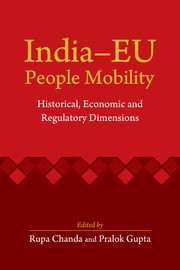Book contents
- Frontmatter
- Dedication
- Contents
- List of Tables, Figures and Boxes
- List of Abbreviations
- Preface
- Acknowledgements
- 1 India–EU People Mobility: Present Status and Policy Perspective
- 2 Economic Linkages and India–EU Mobility
- 3 Indian Diaspora in the EU
- 4 Goans in Portugal: History, Identity and Diaspora Linkages
- 5 Facilitating India–EU Mobility of IT Professionals
- 6 Movement of Indian Architects and Engineers: Prospects and Challenges in the EU
- 7 Mobility of Indian Legal Professionals to the EU: Understanding the EU's Regulatory Regime
- 8 Exploring India–EU Student Mobility
- 9 The Way Forward to a Strategic Engagement
- Contributors
- Index
9 - The Way Forward to a Strategic Engagement
Published online by Cambridge University Press: 05 January 2016
- Frontmatter
- Dedication
- Contents
- List of Tables, Figures and Boxes
- List of Abbreviations
- Preface
- Acknowledgements
- 1 India–EU People Mobility: Present Status and Policy Perspective
- 2 Economic Linkages and India–EU Mobility
- 3 Indian Diaspora in the EU
- 4 Goans in Portugal: History, Identity and Diaspora Linkages
- 5 Facilitating India–EU Mobility of IT Professionals
- 6 Movement of Indian Architects and Engineers: Prospects and Challenges in the EU
- 7 Mobility of Indian Legal Professionals to the EU: Understanding the EU's Regulatory Regime
- 8 Exploring India–EU Student Mobility
- 9 The Way Forward to a Strategic Engagement
- Contributors
- Index
Summary
Introduction
The India–EU engagement has many dimensions. The two sides are bound through commercial, social, educational, cultural, technological, historical and political ties, and people mobility is an important part of this relationship. However, as the authors in this volume highlight, neither India nor the EU has paid sufficient attention to the significance of people mobility in shaping bilateral relations. Both sides have thus far lacked a strategic outlook on the ‘soft power’ that can be derived through mobility and through the presence of a vibrant diaspora community. It is thus not surprising that although emigration from India to the EU has been on the rise, it remains below its true potential, with the EU constituting a relatively small part of India's emigrant flows and with India not featuring as among the main source countries for immigrant flows into the EU, although globally both rank among the leading destination and source markets for migration. Regulatory, cultural and other barriers lie at the heart of this sub-potential engagement. The chapters in this volume emphasize the need for a more strategic partnership between India and the EU, one which recognizes the importance of people-to-people relations, current or historical, in building stronger ties between the two sides, both at the EU-wide level in the context of the ongoing BTIA negotiations and at the bilateral level through negotiations with individual EU member countries.
Going forward, what should constitute the elements of a strategic-mobilitybased partnership between India and the EU? What should be the broad approach and what are some specific issues that need to be addressed? The chapters in this volume provide an outline of the broad framework that is needed. They highlight three dimensions to this framework, namely enhanced dialogue and bilateral exchange of information between EU member governments and India to better understand the issues and appreciate the sensitivities associated with bilateral mobility; increased regulatory and institutional cooperation between concerned agencies, regulatory bodies, and ministries on both sides to address various barriers affecting bilateral mobility; and a conducive environment for strengthening individual and community ties between the two sides.
- Type
- Chapter
- Information
- India–EU People MobilityHistorical, Economic and Regulatory Dimensions, pp. 220 - 226Publisher: Cambridge University PressPrint publication year: 2015



